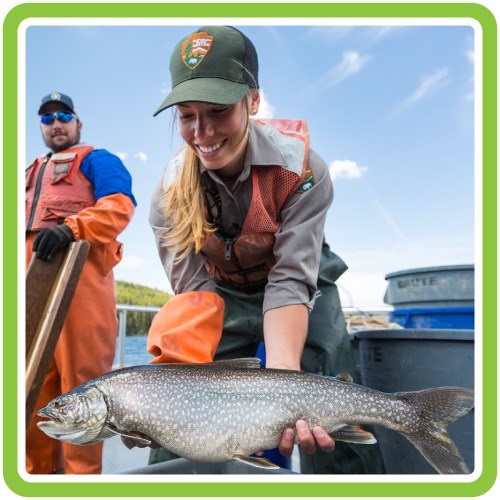
As the world's first national park, Yellowstone did not come with a rule book or a manual on how national parks should be run. Things didn't always go well, but we continue to learn and improve the ways we preserve this amazing place.
To preserve Yellowstone, we must all be good stewards. Stewardship means making a difference in our world and trying to make it a better place. Yellowstone's park rangers were once kids, just like you, and have dedicated their lives to protecting special places like Yellowstone. Beyond Your BackyardThere are more than 400 national park sites in the United States of America. They include parks, battlefields, monuments, seashores, historic sites, and recreation areas. The National Park Service ArrowheadThe arrowhead is the symbol of the National Park Service and what it protects. It is a reminder of the nature and culture national parks protect. Take a look at the arrowhead, then take a look at what each part of the arrowhead represents. 
Geology such as mountains, volcanoes, glaciers, arches, dunes, geologic processes, fossils, and so forth.
Vegetation such as trees, cactuses, grasses, wildflowers, aquatic plants, lichen, and so forth.
Wildlife such as mammals, birds, reptiles, insects, fish, coral, amphibians, mollusks, and so forth.
Water resources such as rivers, lakes, oceans, and shorelines.
Cultural resources and heritage such as Native Americans, explorers, inventors, artists, American history, and technological advancements.

People Who Care for YellowstoneYellowstone is 2.2 million acres. Many people take care of the park. There are rangers who work in education, law enforcement, fire, research, and maintenance. There are park employees who handle budgets, hiring employees, ship packages, plow snow, and repair vehicles. Which of these type of people do you have in your community? Park rangers must have many skills. Their goal is to protect the park for future generations and to protect visitors. Check out the following rangers and their skills. What job do you think they do? 
Ranger on PatrolSome rangers uphold the law and help visitors with emergencies. Some of their skills and duties include:
Visitor and Resource Protection Ranger.

Maintaining the ParkSome rangers focus on building and maintaining the park's buildings, restrooms, recycling bins, roads, and trails. Some of their skills and duties include:
Facilities Management Ranger.

Enriching ExperiencesSome rangers focus on communicating with visitors to help visitors understand the resources being preserved within the park. Some of their skills and duties include:
Interpretive Ranger.

Seeking Better UnderstandingSome rangers focus on understanding the resources preserved within the park, and helping those resources when necessary. Some of their skills and duties include:
Resource Management Ranger.

NASA Yellowstone Goes GlobalYellowstone National Park is a place where scientists can study nature in a nearly unchanged condition. Discoveries in Yellowstone can affect us and the world. There is a lot to learn!

Kids & Youth
What fascinates you about Yellowstone? Personalize your online adventure of the world's first national park. |
Last updated: April 17, 2025
